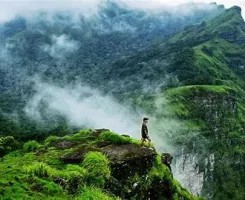Manas National Park Travel Guide
Manas National Park is a UNESCO World Heritage Site located in Assam, India. The park is known for its diverse wildlife, including the majestic Royal Bengal Tigers, Indian Elephants, and Indian Rhinoceros. It is also famous for its stunning landscapes, dense forests, and the Manas River that flows through the park. With a rich history dating back to ancient times, Manas National Park holds great cultural significance for the indigenous Bodo tribes of the region.Top Attractions in Manas National Park
- Jeep Safari through the Wildlife Sanctuary
- Elephant Rides for a Close Encounter with Wildlife
- Bird Watching at the Manas River Banks
- Exploring the Bhutan Border nearby
Manas National Park is Famous for
Its pristine wilderness and incredible biodiversity.Top Attractions in Manas National Park
- Spotting Endangered Species like Golden Langurs
- Visiting the Ancient Manas Maozigendri Ecotourism Society
- Experiencing Tribal Culture in the Villages around the Park
What's Great about Travelling to Manas National Park?
- Unmatched Wildlife Viewing Opportunities
- Perfect for Nature Enthusiasts and Photographers
- Offers a Glimpse into the Tribal Life of Assam
What's Not So Great about Travelling to Manas National Park?
- Remote Location with Limited Accommodation Options
- Weather Can Be Unpredictable, Especially During Monsoon
- Not Ideal for Those Seeking a Luxurious Vacation
Travel Tips for Manas National Park
- Obtain Necessary Permits for Entry into the National Park
- Book Accommodation in Advance due to Limited Availability
- Follow Safety Guidelines During Wildlife Safaris
Important Manas National Park trip information
- Ideal Duration: 2-3 Days
- Best Time to Visit: November to April
- Nearby Airports and Railway Stations: Guwahati Airport and Barpeta Road Railway Station
Per Person
34,990
*EXCLUDING APPLICABLE TAXES Per Person
24,400
*EXCLUDING APPLICABLE TAXES Per Person
19,000
*EXCLUDING APPLICABLE TAXES 5.0 Ratings
( 8 Reviews )
( 8 Reviews )
Per Person
18,000
*EXCLUDING APPLICABLE TAXES Per Person
15,000
*EXCLUDING APPLICABLE TAXES Per Person
40,000
*EXCLUDING APPLICABLE TAXES FAQ's on Manas National Park
Q1: What is the best time to visit Manas National Park?
The best time to visit Manas National Park is from November to April when the weather is pleasant, and wildlife sightings are more common. This period also coincides with the dry season, making it easier to explore the park on safaris and hikes. Avoid the monsoon season from June to September as heavy rains can lead to road closures and limited wildlife sightings.
Q2: Do I need a visa to travel to Manas National Park?
Tourists visiting Manas National Park in India may require a visa. Check the current visa requirements for your nationality before planning your trip. Some countries are eligible for e-visas or visa on arrival, but it's essential to ensure you have the necessary documentation before arrival.
Q3: What are the must-visit attractions in Manas National Park?
Some of the must-visit attractions in Manas National Park include the iconic Manas River, the endangered Indian rhinoceros at the Rhino Reserve, and the diverse bird species at the bird watching sites. Don't miss exploring the lush forests, grasslands, and wetlands that are home to a variety of wildlife, including tigers, elephants, and wild water buffaloes.
Q4: Is Manas National Park a safe place to travel?
Manas National Park is generally safe for tourists, but it's essential to follow park guidelines and stay with authorized guides during safaris. Be cautious of wild animals and avoid wandering off designated paths. It's also advisable to check with local authorities for any recent safety updates before your visit.
Q5: What is the local currency in Manas National Park and can I use credit cards?
The local currency in India, including Manas National Park, is the Indian Rupee (INR). While major cities may accept credit cards, it's recommended to carry cash for smaller purchases and transactions. ATMs are available in nearby towns, but it's advisable to withdraw cash before entering the park.
Q6: What is the local cuisine like in Manas National Park?
The local cuisine in Manas National Park and its surrounding regions offers a variety of flavors and dishes. Enjoy traditional Assamese cuisine like rice, fish, and flavorful curries. Don't miss trying the local specialty, Assam tea, known for its strong and aromatic taste. Vegetarians will also find delicious options like dal (lentil curry) and a variety of vegetable dishes.
Q7: What transportation options are available in Manas National Park?
Transportation options in Manas National Park include private taxis, rental cars, and guided tours for exploring the park. Public buses and shared jeeps are available to reach nearby towns like Barpeta and Baksa. It's recommended to hire a local guide or join a safari tour for wildlife viewing within the park, as they provide transportation and valuable insights on the area.
Q8: Are there any cultural norms or etiquette I should be aware of when visiting Manas National Park?
When visiting Manas National Park, it's important to respect local customs and traditions. Dress modestly, especially when visiting religious sites or interacting with local communities. Ask for permission before taking photographs of people or religious sites. Avoid public displays of affection and be mindful of the environment by not littering. Learning a few basic phrases in Assamese can also show respect for the local culture and enhance your travel experience.
Q9: I am a travel agent. How can I buy travel leads of Manas National Park?
Register yourself as a travel agent at agents.tripclap.com and then you can buy travel leads to Manas National Park once your account is approved. For more details contact our support team at +91-8069186564 or support@tripclap.com







